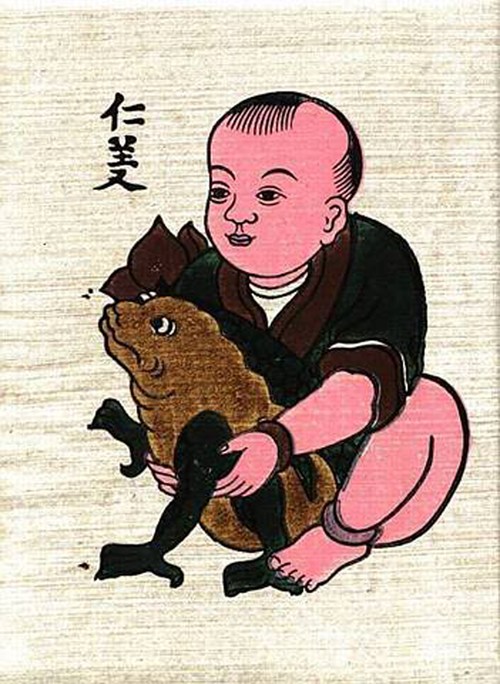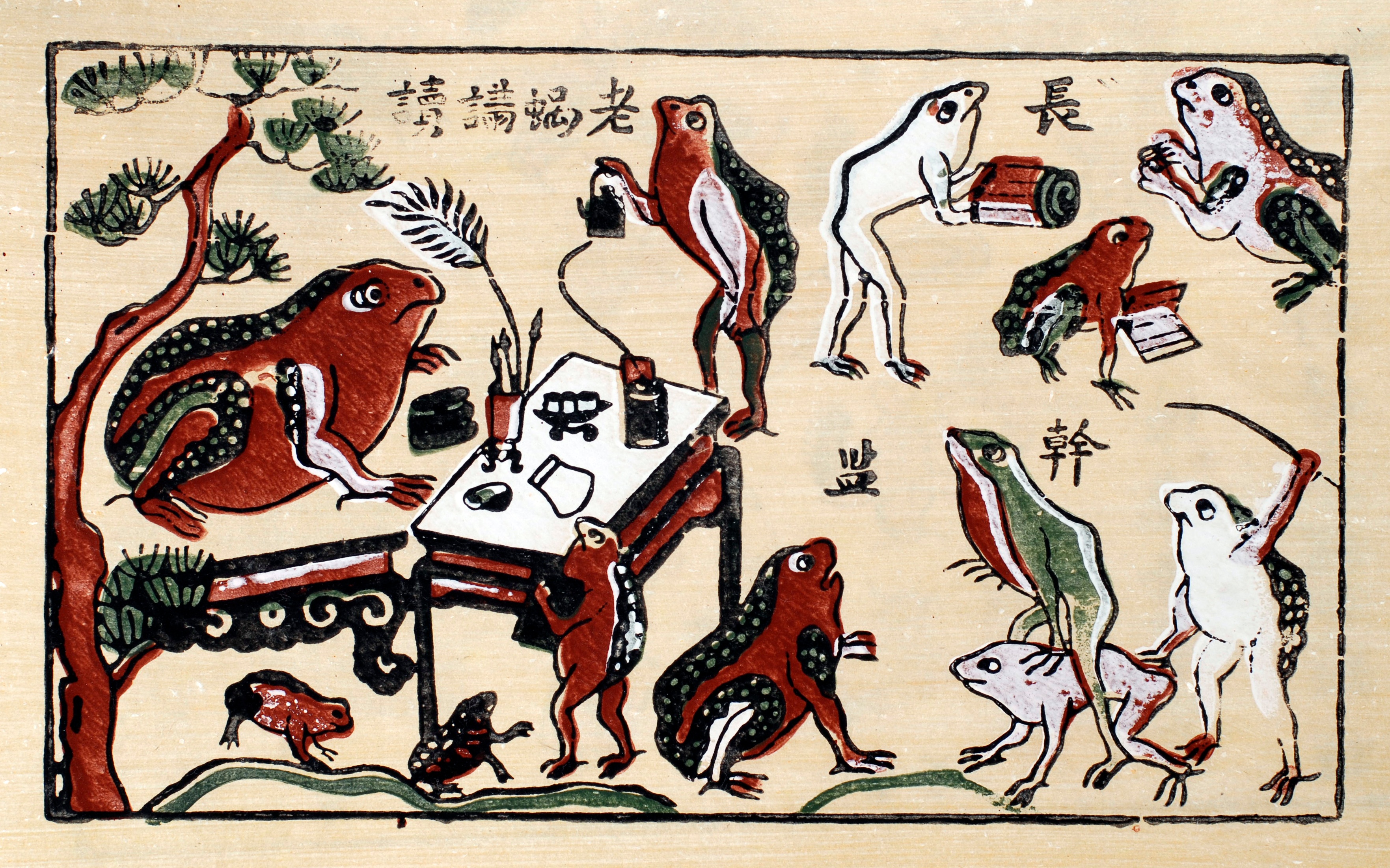Toad (band), Toad on:
[Wikipedia]
[Google]
[Amazon]
Toad is a common name for certain

 In
In
frog
A frog is any member of a diverse and largely Carnivore, carnivorous group of short-bodied, tailless amphibians composing the order (biology), order Anura (ανοὐρά, literally ''without tail'' in Ancient Greek). The oldest fossil "proto-f ...
s, especially of the family Bufonidae, that are characterized by dry, leathery skin, short legs, and large bumps covering the parotoid gland
The parotoid gland (alternatively, paratoid gland) is an external skin gland on the back, neck, and shoulder of toads and some frogs and salamanders. It can secrete a number of milky alkaloid substances (depending on the species) known collective ...
s.
A distinction between frogs and toads is not made in scientific taxonomy
Taxonomy is the practice and science of categorization or classification.
A taxonomy (or taxonomical classification) is a scheme of classification, especially a hierarchical classification, in which things are organized into groups or types. ...
, but is common in popular culture ( folk taxonomy), in which toads are associated with drier, rougher skin and more terrestrial habitats.
List of toad families
In scientific taxonomy, toads include thetrue toads
A true toad is any member of the family Bufonidae, in the order Anura (frogs and toads). This is the only family of anurans in which all members are known as toads, although some may be called frogs (such as harlequin frogs). The bufonids now ...
(Bufonidae) and various other terrestrial or warty-skinned frogs.
Non-bufonid "toads" can be found in the families:
* Bombinatoridae (fire-bellied toads
fire-bellied toads are a group of six species of small frogs (most species typically no longer than ) belonging to the genus ''Bombina''.
The name "fire-bellied" is derived from the brightly colored red- or yellow-and-black patterns on the toa ...
and jungle toads)
* Calyptocephalellidae
The Calyptocephalellidae are a family of toads (although not true members of the Bufonidae) found in Chile containing two living genera, ''Calyptocephalella'' and ''Telmatobufo.''
The genus ''Calyptocephalella'' contains one living species, the ...
( helmeted water toad and false toads)
* Discoglossidae ( midwife toads)
* Myobatrachidae
Myobatrachidae, commonly known as Australian ground frogs or Australian water frogs, is a family of frogs found in Australia and New Guinea. Members of this family vary greatly in size, from species less than long, to the second-largest frog in ...
(Australian toadlets)
* Pelobatidae
The European spadefoot toads are a family of frogs, the Pelobatidae, with only one extant genus ''Pelobates'', containing six species. They are native to Europe, the Mediterranean, northwestern Africa, and western Asia.
Description
The Europe ...
(European spadefoot toad
The European spadefoot toads are a family of frogs, the Pelobatidae, with only one extant genus ''Pelobates'', containing six species. They are native to Europe, the Mediterranean, northwestern Africa, and western Asia.
Description
The Europe ...
)
* Rhinophrynidae ( burrowing toads)
* Scaphiopodidae (American spadefoot toads
The Scaphiopodidae are a family of American spadefoot toads, which are native to North America. The family is small, comprising only seven different species.
The American spadefoot toads are of typical shape to most fossorial (or burrowing) fro ...
)
* Microhylidae
The Microhylidae, commonly known as narrow-mouthed frogs, are a geographically widespread family of frogs. The 683 species are in 63 genera and 11 subfamilies, which is the largest number of genera of any frog family.
Evolution
A molecular phylo ...
( narrowmouth toads)
Biology
Usually the largest of the bumps on a toad's skin are those that cover the parotoid glands. The bumps are commonly called warts, but they have nothing to do with pathologic warts, being fixed in size, present on healthy specimens, and not caused by infection. It's a myth that handling toads causes warts. Toads travel from non-breeding to breeding areas of ponds and lakes. Bogert (1947) suggests that the toads' call is the most important cue in the homing to ponds. Toads, like many amphibians, exhibit breeding site fidelity (philopatry
Philopatry is the tendency of an organism to stay in or habitually return to a particular area. The causes of philopatry are numerous, but natal philopatry, where animals return to their birthplace to breed, may be the most common. The term derives ...
). Individual American toads return to their natal ponds to breed, making it likely they will encounter siblings when seeking potential mates. Although inbred examples within a species are possible, siblings rarely mate. Toads recognize and avoid mating with close kin. Advertisement vocalizations given by males appear to serve as cues by which females recognize kin. Kin recognition thus allows avoidance of inbreeding and consequent inbreeding depression
Inbreeding depression is the reduced biological fitness which has the potential to result from inbreeding (the breeding of related individuals). Biological fitness refers to an organism's ability to survive and perpetuate its genetic material. In ...
.
Habitat
In the United Kingdom, common toads often climb trees to hide in hollows or in nest boxes.Cultural depictions

 In
In Kenneth Grahame
Kenneth Grahame ( ; 8 March 1859 – 6 July 1932) was a British writer born in Edinburgh, Scotland. He is most famous for ''The Wind in the Willows'' (1908), a classic of children's literature, as well as ''The Reluctant Dragon (short story), T ...
's novel ''The Wind in the Willows
''The Wind in the Willows'' is a children's novel by the British novelist Kenneth Grahame, first published in 1908. It details the story of Mole, Ratty, and Badger as they try to help Mr. Toad, after he becomes obsessed with motorcars and gets ...
'' (1908), Mr. Toad
Mr. Toad, of Toad Hall, is one of the main characters in the 1908 novel ''The Wind in the Willows'' by Kenneth Grahame, and also the title character of the 1929 A. A. Milne play ''Toad of Toad Hall'' based on the book.
Inspiration
The inspiration ...
is a likeable and popular, if selfish and narcissistic, comic character. Mr. Toad reappears as the lead character in A. A. Milne's play ''Toad of Toad Hall
''Toad of Toad Hall'' is a play written by A. A. Milne – the first of several dramatisations of Kenneth Grahame's 1908 novel ''The Wind in the Willows'' – with incidental music by Harold Fraser-Simson. It was originally produced by Willia ...
'' (1929), based on the book.
In Chinese culture, the Money Toad (or Frog) Jin Chan
The Jin Chan (), also called Chan Chuy () or "Zhaocai Chan Chu" (), is most commonly translated as "Money Toad" or "Money Frog". It represents a popular feng shui charm for prosperity.
This mythical creature is said to appear during the full moon ...
appears as a feng shui charm for prosperity.
See also
* True toad * Common toadReferences
External links
* {{Cite EB1911, wstitle=Toad , volume=26 , page=1035 , short=x * Amphibian common names